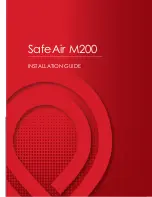
V.033007
Sprint
®
2000
4.2 Installation
Safety
Precautions
1. Installation of this appliance must conform with local codes, or in the absence of local codes,
with the National Fuel Gas Code, ANSI-223.1 – Latest Edition.
2. The dryer and shut off valve must be disconnected from the gas supply during pressure testing.
3. The dryer must be isolated from the gas supply piping system by closing its individual manual
shut off valve during any pressure testing of the gas supply piping system at test pressures
equal to or less than 1/2 psig (3.5 kPa).
4. When installed, dryer must be electrically grounded in accordance with local codes or, in the
absence of local codes, with the National Electrical Code ANSI/NFPA 70 - Latest Edition.
5. Dryer must not be installed or stored in an area where it will be exposed to water and/or weather.
6. Clearances from combustible construction as follows: sides (left and right) 36” (91 cm), rear 36”
(91 cm), ceiling 36” (91 cm). When installing on combustible flooring, the leveling legs must be
adjusted for maximum height. Failure to comply with this instruction may cause a fire hazard.
5. Operation
5.1 Principles
of
Operation
Drying
Principle
This dryer is designed for curing/drying plastisol inks.
Plastisol
Heat cures plastisol by creating a chemical bond (crosslink) between plastisol molecules, rather than
by evaporation.
Byproducts of the curing process are vented out the exhaust duct.
IMPORTANT:
Always check and confirm cure/dry results before starting a production run.
Due to the variations in garments, inks, and the application process, we disclaim all liability for
damage or loss related to inconsistent printing variables.
5.1.1 Curing
Inks
Curing/Drying
Plastisol Inks
Plastisol inks will not air dry or permanently adhere to garments unless fused with heat.
Results vary by temperature.
1.
110 degrees F (43.3 degrees C):
the fusion process begins
2.
125 degrees F (51.6 degrees C):
the ink viscosity will decrease to its lowest point and
the ink surface begins to flow or level
3.
240 degrees F (115.5 degrees C):
plastisol begins to gel (this temperature range is
typical for printing transfers)
4.
325 to 350 degrees F (162.7 – 176.6 degrees C):
the typical fusion temperature for
plastisol inks (consult your ink manufacturer for more accurate specifications)
Testing
Plastisol for
Proper Cure
When properly cured, plastisol inks produce prints that are extremely durable and wash
resistant. These attributes should be tested when checking for proper cure.
M&R Companies 1N 372 Main St. Glen Ellyn, IL 60137 USA
17
Tel: +630-858-6101 Fax: +630-858-6134
www.mrprint.com
















































